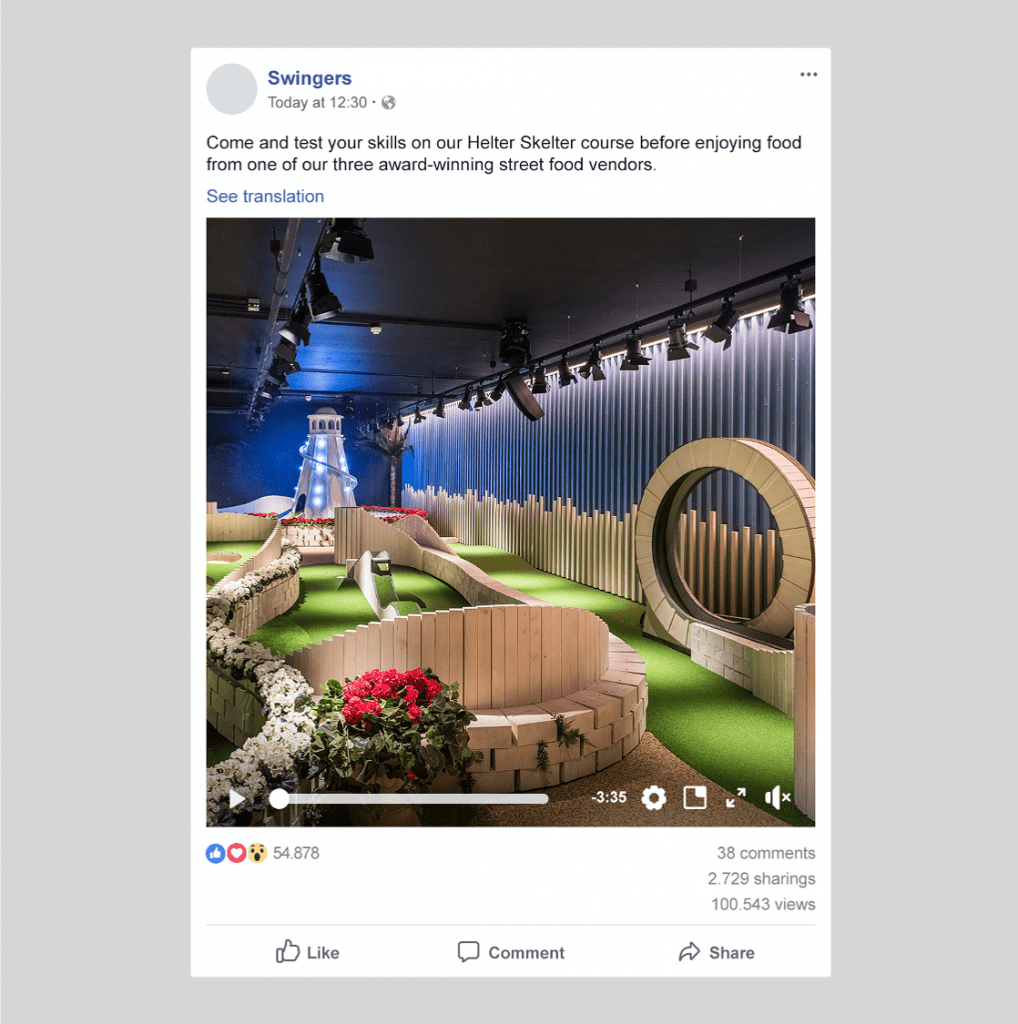Tom will be giving a series of live classes on Mastering Online Qualitative Research throughout May 2020. If you want to be a better online qual researcher, find out more and enrol here.
Overview
What’s in a name? What did you assume when you read the word ‘Swingers’? Is it the kind of place you’d want to see springing up on your local high street?
Last year, I was approached by the entertainment company ‘The Institute of Competitive Socialising’. They wanted to evaluate the opportunity to expand their Urban Golf concept: ‘Swingers, the Crazy Golf Club’, into America. They had to work out whether the name ‘Swingers’ might provoke negative reactions, given the potentially risqué connotations.
Our ‘mobile-first’ approach to the brief helped get us nominated in the 2018 MRS (Market Research Society) ‘Best Independent Consultancy’ award. Here’s an overview of it for anyone interested in online and mobile qualitative research. The method highlights the power of remote mobile qualitative research not just to conduct more authentic research, but also to handle studies remotely – which is of vital importance today.
The founder of Swingers – Jeremy Symmonds – had seen lots of Millennials research when he ran a Youth Engagement agency. However, he was concerned that traditional focus groups would yield artificial results because of the artificiality of the setting and the group and researcher effects at play. He challenged us to go further to get authentic insight.
In our ‘mobile-first’ approach we asked millennials to share video feedback of their nights out. We also got them to share screen recordings of mobile interactions with night-life websites along with their verbal commentary of the experience. And we went the extra mile to develop stimulus that really brought the Swingers experience to life for them. This included mocking up Facebook ads and magazine reviews as if it had launched in their city already. This helped participants judge the concept more meaningfully and allowed them to express themselves on their terms, both of which inspired the client to proceed with their launch.
The Challenge
In recent years, The Institute of Competitive Socialising have successfully launched ‘Swingers – The Crazy Golf Club’ across two sites in London. Swingers is a premium, mini-golf experience for Millennials that turns over £20m a year. They wanted to expand globally, starting with America. So research was required to ensure that the concept (and its potentially controversial name) would be a success if it launched.
On this project, the client and founder – Jeremy Symmonds (winner of Young Gun Entrepreneurs Award 2018 and a former advertising executive), came to Feeling Mutual with a healthily cynical attitude to traditional qualitative research methods. In his advertising days, he specialised in brand experiences for Millennials, but had reservations about the validity of traditional qualitative methods.
The client had two concerns. First, he felt that group discussions with Millennials often feel artificial; not just because young people are not used to talking in such a formal setting, but also because they are more likely to be influenced by the others. Secondly, he was concerned that if we took a typical approach to creating stimulus (using just written descriptions and photos of the event), there would be a risk that participants might fail to imagine what the experience would really be like. And so their judgements would not be as predictively accurate.
It was essential that our research enabled the client to accurately judge how likely Millennials would be to attend Swingers, if it launched in America. Not just to convince the client but also their investors. So they challenged us to design a method that they felt confident making decisions off the back of.
Mobile First Solution
In order to achieve this, Feeling Mutual took a ‘mobile first’ approach to understanding Millennial youth culture and went further to develop stimulus that would help them imagine the concept as realistically as possible.
We worked with the mobile research app Indeemo to manage the discussion. This allowed people to give their feedback via mobile video, text and by annotating photos. Communicating by mobile is far more natural for young people, than in a viewing facility. We were able to use a feature that lets people record their mobile screen as they interact with a site or other app, while they record their voice commentary of whatever they think and feel.
This takes the researcher closer to real world moments as they unfold. This meant their feedback was not as post-rationalised, filtered or based on erroneous memories as it might have been with traditional focus groups in a viewing facility. Also many research platforms struggle when you have too much video content, which can be very data-heavy, in this HD, 4K world of mobile technology. Indeemo’s tools allowed us to manage feedback easily, probe and tag comments. We also used the trimming feature so we could easily go from analysis to a media-rich video report.
A sample of 12 young people were recruited based on their social behaviours, interest in competitive socialising, income, where they live and work (see appendix 1). They took part in the mobile qualitative study across a week. We looked at their level of social influence in their peer-group based on social media followers and engagement online too. This meant we knew we had truly socially influential ‘taste-makers’ taking part.

They were recruited from Facebook working with Liveminds Behavioural Recruitment, so we could geo-target people based on an interest in golf and the fact they lived near to where the venue was being launched.
This meant they had never done research before and were more engaged in the process as a result. A series of exercises were designed to take us closer to their lives. Overall, we received over 10 hours of feedback from them. All feedback was in private (reducing any research effect).
They were asked to keep a mobile video diary of the steps they go through when deciding on where to go on a night out with friends.
They shared conversations with their friends, screen recordings of social media interactions, local city reviews of where to go out, and more. This allowed us to understand the criteria they use to decide on where to go out. We also got them to share videos and pictures of their night out. This allowed us to develop a model of their decision making process. It was clear which criteria mattered most to them. We used this as an evaluative framework for assessing their reactions to Swingers, which gave the client more confidence in the conclusions and their potential application in the real world.
In the second part of the study required we shared the idea of Swingers with them, as vividly as possible, so that they could really imagine it and therefore judge it meaningfully. The client was worried that written descriptions of the experience and photos alone would not be enough to achieve this. So we worked with their video and design teams to create stimulus which made it look as though Swingers had already launched. We drip fed this stimulus to them (replicating how they might have realistically come across the venue in the real world). We were able to get their gut reactions to genuine touchpoints, in the same context and via the same medium in which they would have encountered them in reality.
The stimulus of the venue included a mocked up journalistic review from a local night-out review site, and a mocked-up Facebook ad – as if it had already launched. We also used video footage from the existing London venue. This meant that they were responding to content about the venue, as it would appear to them in the real-world as if it had already launched. This made us more confident about their judgements than had we shown them typical written concept descriptions.
Throughout the research we listened for mentions to do with negative sexual connotations associated with the brand name ‘Swingers, The Crazy Golf Club’. Although, some issues were raised, when they saw how impressive the quality of the venue was, these soon disappeared.
They were able to appreciate this because of the video of the venue that helped them feel like they were actually there.
The third part of the study was dedicated to tuning the brand experience into the local culture, while staying true to its original conception. To do this we got them to suggest local food and drinks brands and to review our suggestions for local partner brands.
We got them to share ideas on how the mini-golf course design might be developed to fit with American tastes. The participants were carefully selected to be social taste-makers and so represented a harder audience to convince.
The research method created a template for evaluating risk and potential reward pre-launch. This will be rolled out across other markets as the brand continues to grow around the world.
The Impact
The fact they answered by mobile, in a real world context and responded to stimulus that mimicked real world touchpoints, gave us far more confidence in their feedback.
Jeremy their founder, said this about the impact we had on their investment decision and our approach:
“Before launching Swingers, I worked for an ad agency, targeting Millennials so I know what a hard nut to crack they are. You have to understand culture first and get into their actual lives in order to truly understand them. Call me cynical but I do not trust traditional methods which can be too artificial and hypothetical. Tom’s approach allowed us and our investors to make more confident decisions about the global roll out.
He challenged us to mock up content to make it look as if the venue had already launched. This meant they were reacting to stimulus that they would likely have encountered in the real world. Also it was great to see feedback in video; it made the study a lot more compelling. The fact they answered by mobile, in a real world context and responded to stimulus that mimicked real world touchpoints, gave us far more confidence in their feedback.
The research gave us confidence to proceed with the launch. It helped us stay true to our UK brand identity while also understanding local nuances. We had concerns with the name ‘Swingers’ given the possible connotations – and these were allayed. It helped us to commit to a particular site within the city – since we had detailed local insights.
I like the idea of letting young people express themselves in ways that are natural to them. Mobile feedback is far more natural than traditional focus group settings with their two-way mirrors and the group discussion context. We plan to roll this method out across future launches around the world”.
Conclusion
In conclusion, mobile qual encourages greater authenticity by getting into people’s real worlds and stripping away the artificial research and group effects of traditional research. It pays to engage Millennials on their terms. Given that Millennials are now a bigger group in the UK than Baby Boomers – a shift in methodology towards media that are more natural for them was a key step.
If you’d like to master online and mobile qual, you can find out about the author, Tom Woodnutt’s training course here.
